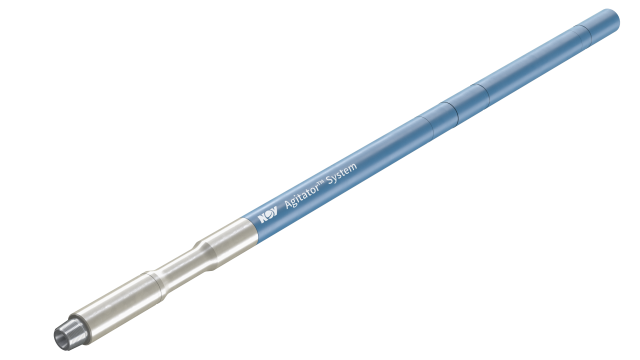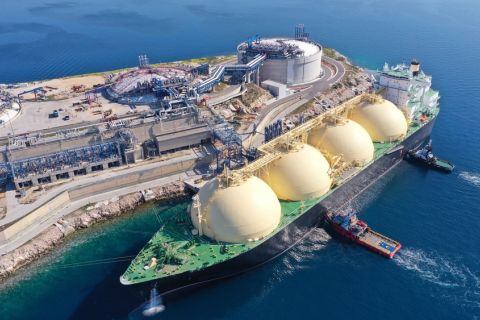
The Agitator systems axial oscillations provide significant benefits for wellbore intervention and fishing applications. (Source: NOV)
Proven systems become proven through years of use in the field and repeated successes. It is through these continued successes that the main purpose and functionality of the system is established and solidified. In some cases, a proven system can be used in a more novel application, opening up an entirely new market. Such is the case with the Agitator system from National Oilwell Varco (NOV).
The Agitator uses friction reduction, achieved via an axial oscillation motion in the drillstring, to improve ROP and weight transfer and reduce stick/slip in drilling applications. Though the most common use of the system is to improve drilling performance, Agitator technology also can be used to enable more effective fishing operations. This novel application of a proven technology highlights the versatility of downhole tools.
Case histories
An operator in the Austin Chalk was facing the loss of a mechanically stuck fish in a challenging formation. The fish was a service company’s extremely valuable MWD system valued at more than $750,000. The company engineer called NOV to discuss methods that could help get the bottomhole assembly (BHA) out of the hole, with NOV recommending that the engineer try using an Agitator system to vibrate the fish loose.
After some initial skepticism and a lengthy call with various representatives from all companies, the decision was made to use an AgitatorHE, the high-energy version of the original Agitator, to help fish out the BHA. The system was shipped immediately and delivered to the customer.
The tool was in the formation from a stuck point at 3,589 m (11,775 ft) to the top of fish at 2,943 m (9,654 ft) in an 8½-in. hole. The operator placed the AgitatorHE system within a traditional fishing BHA to promote axial vibrations while exciting the fish once latched. Hydraulics were run prior to the job to optimize harmonics and frequency with respect to mud weight and flow rate. The 6¾-in. AgitatorHE system was placed 0.92 m (3.03 ft) behind the screw-in sub to maximize energy exerted directly on the fish. The customer was able to flow 625 gal/min through the AgitatorHE and successfully retrieved 646 m (2,121 ft) of fish, eliminating potential lost-in-hole charges.
An operator in the U.K. North Sea needed to retrieve 71 m (232 ft) of 133⁄8-in. casing from an exploratory well. The initial plan was to try to retrieve the whole casing section in one run, and the operator chose an 8-in. Agitator system to use in conjunction with a standard jar and accelerator fishing BHA. Once on the bottom with the spear engaged, agitation commenced. After 30 minutes, the overpulls were increased, and the jar was fired. The cycle of jarring and agitating continued for a few hours. Large deposits of cement were observed during this time over the shakers. Once a significant reduction of cement returns was observed over the shakers, it was decided to pull out of the hole.
It was then decided to cut the casing into smaller sections and try to retrieve it with the help of the Agitator system in the fishing BHA. The 133⁄8-in. casing was retrieved in four sections (15 m, 17.3 m, 17 m and 20.7 m [49 ft, 57 ft, 56 ft and 68 ft]) over the next three days. In addition to helping the operator retrieve all 71 m of casing, the Agitator system also helped in disturbing and clearing the cement behind the casing. Furthermore, by increasing the efficiency of the casing retrieval operation, the system helped the operator save valuable rig time.
In another offshore project, an operator in the Caspian Sea needed to fish the maximum retrievable amount of 95⁄8-in. casing to carry out a sidetrack inside of the 133⁄8-in. casing, but the height of cement used to secure the casing was positioned higher than planned. The operator was prepared to cut and pull the casing pieces using the traditional method of overpulling and jarring. This method would require multiple cuts to retrieve the casing, which would increase costly rig time.
In the first use of an Agitator system for a fishing application in the region, the operator implemented an 8-in. Agitator paired with the multiple opening circulation sub below it, with the ball preset internally. The fishing BHA included a spear and pack-off below and a traditional jar and accelerator above. NOV recommended the operator jar and then agitate in 30-minute cycles until the fish was freed, working at a flow rate of 700 gal/min and mud weight of 14 ppg to ensure optimal impact. During the retrieval of a 68 m (223- ft) piece of casing, the Agitator system was used for 4 hours in cycles of 30 minutes of jarring and 30 minutes of oscillation, and large pieces of cement were observed at the shakers. After the fifth cycle, the weight dropped considerably, and the fish was freed, with the operator deciding to sidetrack at a shallower depth due to there being a full circle of cement in the annulus.

Conclusion
Use of existing technologies in new applications often prolongs their use, lengthening the commercial cycle. Determining novel uses of proven systems helps companies confirm that additional development to advance greater functionality and purpose is warranted. This will remain a critical consideration as the oil and gas industry is faced with persistent capital constraint and market volatility.
In the case of the Agitator system from NOV, using an Agitator as part of a fishing BHA is just one way the system is penetrating new markets. Another area of interest that NOV has identified through discussions with operators and service companies is pairing Agitator systems with rotary steerable systems (RSS) in the BHA to help protect the RSS from downhole damage and improve steerability and wellbore quality. Future development of the tool will focus on increasing performance and on identifying other areas of application that will help increase efficiency.
Recommended Reading
US Eases Tailpipe Rules, Slows EV Transition Through 2030
2024-03-20 - The Biden administration is unveiling final rules on March 20 that make it easier for automakers to continue selling gas-powered models and slows the projected transition to electric vehicles through 2030.
Venture Global Seeks FERC Actions on LNG Projects with Sense of Urgency
2024-02-21 - Venture Global files requests with the Federal Energy Regulatory Commission for Calcasieu Pass 1 and 2 before a potential vacancy on the commission brings approvals to a standstill.
The Problem with the Pause: US LNG Trade Gets Political
2024-02-13 - Industry leaders worry that the DOE’s suspension of approvals for LNG projects will persuade global customers to seek other suppliers, wreaking havoc on energy security.
Despite LNG Permitting Risks, Cheniere Expansions Continue
2024-02-28 - U.S.-based Cheniere Energy expects the U.S. market, which exported 86 million tonnes per annum (mtpa) of LNG in 2023, will be the first to surpass the 200 mtpa mark—even taking into account a recent pause on approvals related to new U.S. LNG projects.
Biden Administration Criticized for Limits to Arctic Oil, Gas Drilling
2024-04-19 - The Bureau of Land Management is limiting new oil and gas leasing in the Arctic and also shut down a road proposal for industrial mining purposes.




